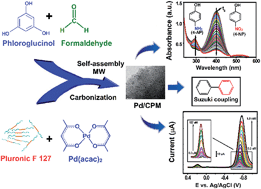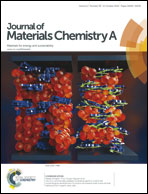Highly stable and active palladium nanoparticles supported on porous carbon for practical catalytic applications†
Abstract
Carbon porous materials (CPMs) containing highly dispersed palladium nanoparticles (PdNPs) with an average size of ca. 5 nm were synthesized by microwave (MW) irradiation procedure, during which the Pd2+ ions were effectively reduced to the Pd0 form and highly dispersed on the carbon support. The Pd/CPM samples were characterized by a variety of analytical and spectroscopy techniques, viz. N2 adsorption/desorption isotherm measurements, thermogravimetric analysis (TGA), X-ray diffraction (XRD), scanning and field emission transmission electron microscopy (SEM/FETEM), Fourier transform infrared spectroscopy (FT-IR), and Raman spectroscopy. The Pd/CPM composites were employed as heterogeneous catalysts for the reduction of 4-nitrophenol (4-NP) to 4-aminophenol (4-AP) in aqueous media. The reaction was monitored by UV-Visible spectroscopy, yielding a pseudo-first-order rate constant (k) of 6.87 × 10−2 s−1. Moreover, the catalysts were exploited for C–C coupling reactions using the microwave (MW) method. In addition, a novel electrochemical sensor for the detection of 4-NP was developed based on a Pd/CPM-modified glassy carbon electrode (GCE) using cyclic voltammetry (CV) and differential pulse voltammetry (DPV) methods. The 4-NP sensor was found to exhibit excellent sensitivity, lower detection limit, reliability, and durability surpassing the reported modified electrodes, rendering practical industrial applications.



 Please wait while we load your content...
Please wait while we load your content...